 |
|

|
 |
TABLE of CONTENTS
 |
“Unweave the Weave” project marks completion |
By R. Kent Barnard, Metro District public affairs coordinator
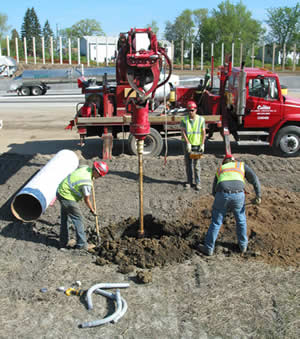
Contractor employees from Collisys dig a hole to install light poles as part of the "Unweave the Weave" project. The project marked its offical end on Oct. 23 with a ceremony that included Gov. Tim Pawlenty, Commissioner Tom Sorel and local officials from Little Canada and Vadnais Heights. Photo by Kent Barnard |
The “Unweave the Weave” project through Little Canada and Vadnais Heights is officially unwoven.
Federal, state and local officials gathered Oct. 23 to mark completion of the four-year construction project, which was one of 12 large-scale projects accelerated in 2003 under the Pawlenty-Molnau Administration’s $900 million transportation finance package.
The project rebuilt the Interstate 35E and I-694 interchanges within the interstates’ common section in Little Canada and Vadnais Heights. Other project features include:
- Reconstructing 3.2 miles of I-35E and 2.8 miles of I-694 from four lanes to six lanes
- Constructing eight highway bridges, storm water ponds, noise walls and other aesthetic enhancements
- Reducing the number of weaves to ease congestion and smooth traffic flow
Gov. Tim Pawlenty kicked off the event, which was attended by a crowd of nearly 100 people. Other speakers included Commissioner Tom Sorel, representatives from the cities of Little Canada and Vadnais Heights, and Metro District Engineer Scott McBride. Frank Pafko, former Metro District North Area manager, served as master of ceremonies and shared his thoughts about the project that began under his watch.
In place of the usual ribbon-cutting, a rope, woven together in the middle, was pulled apart by the speakers to ceremoniously represent completion of the project.
Although the project is substantially complete, crews are wrapping up some minor finishing work including grading, sign installation and various other small tasks.
For more information about the project, see http://www.dot.state.mn.us/metro/projects/unweave/. |
 |
|

|
 |
TABLE of CONTENTS
 |
Land Management’s Catherine Ashlin dies suddenly |
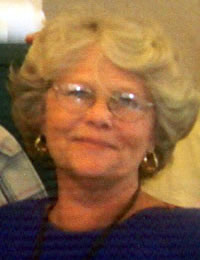
Cathie Ashlin, Land Management, died from a brain aneurism on Oct. 31. |
Catherine (Cathie) Ashlin, Office of Land Management, died Oct. 31 from a brain aneurism.
She was 58.
Visitation was held Nov. 5. A 10 a.m. funeral Mass will be held Nov. 6 at St. John’s Catholic Church, 977 E. Fifth St., St. Paul. Visitation also will be held at 9 a.m., Nov. 6, at the church.
Ashlin’s survivors include a daughter, April Weingartz, and a granddaughter.
Ashlin began her career with Mn/DOT in 2001 with Consultant Services. She transferred to Land Management in 2002 as a contract administrator with the Appraisal and Contracting Unit.
Before joining Mn/DOT, Ashlin was a contract administrator with the 3M Corp. in St. Paul.
Skip Pitzen, who was Ashlin’s supervisor, said she was “delightful to have around.”
“Cathie did her work well, was a knowledgeable contract administrator and would take on any task willingly,” he said.
Coworker Mary Johnson said Ashlin was “funny, bright and quick-thinking.”
“Cathie got along well with all of her coworkers,” Johnson said. “We will miss her; her loss leaves a huge empty spot here for all of us.”
|
 |
|

|
 |
TABLE of CONTENTS
 |
Grooved pavement markings promise better visibility when the going gets wet |
|
By Craig Wilkins
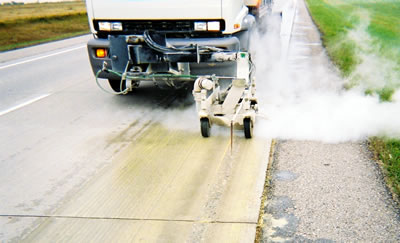
A contractor scores grooves for exit markings on I-94 near Rothsay. Staff from the District 4 Resident Office managed the completion of the project. Photo by Jerry Messerschmidt |
A section of Interstate 94 may provide an extra margin of safety in wet conditions from new, highly reflective paint markings on the pavement between Osakis and Barnesville in District 4.
The paint markings include glass beads and ceramic elements that bend light back toward motorists to help them determine locations of driving lanes, edge lines and merge indicators when they are dry or covered by a thin film of water.
Jon Jackels, state pavement marking, work zone and new products engineer, said glass beads in the paint work well when the road surface is dry. When covered with moisture, however, standard paint markings act like mirrors, often creating glare.
“The ceramic bead clusters bend enough light back from a vehicle’s headlights to work effectively when road surfaces are wet,” he said.
Jackels likened the ceramic clusters’ ability to refract light to the oft-used example of a pencil that appears to bend when placed in a glass of water because air and water refract light differently.
The paint is placed in shallow grooves scored in the pavement surface. The grooves prevent snowplows from scraping the paint away, he said.
The test section of the freeway will provide measurable data about the markings to guide future decisions about their use.
Cost of the test materials and methods is high, Jackels said.
“Costs are about four times greater with for this project than with our standard glass bead striping paints and standard application methods,” he said. “However, we may realize improved economy in the future due to reduced maintenance and our ability to use same groove for future installations.”
Brad Estochen, assistant state traffic safety engineer, said the high number of run-off-the-road crashes justifies providing extra visibility during inclement weather.
“We want the drivers to stay on the road,” he said. “Installation of the wet reflective markings will provide a basis to determine if they are effective in reducing the number of these kinds of crashes.”
Jackels said he expects that continued monitoring of the test section will yield useful data for future pavement marking decisions.
“This unique pilot project will enable us to monitor performance, compare crash rates and help us determine the cost-effectiveness of using ceramic beads and paint grooves,” he said.
|
 |
|

|
 |
TABLE of CONTENTS
 |
Deer alert system near Camden State Park proves effective |
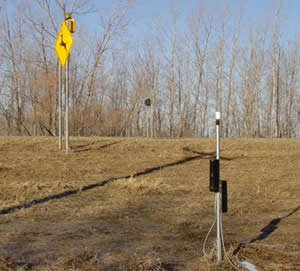
The deer alert system consists of traditional deer warning signs with an amber beacon mounted on top. Motion sensors are placed at the far edge of the ditch (foreground) to create a sensory perimeter. When a deer or other large animal crosses the path of the sensor, a transmitter activates the amber warning lights for 45 seconds. |
The deer alert system installed on Hwy 23 along Camden State Park about 11 miles southwest of Marshall in 2007 has seen a 57 percent reduction in deer-vehicle collisions in the 17 months since the system was installed, according to Bob Weinholzer, project manager.
The alert system consists of traditional deer warning signs with an amber beacon mounted on top. Motion sensors are placed at the far edge of the ditch to create a sensory perimeter. When a deer or other large animal crosses the path of the sensor, a transmitter activates the amber warning lights for 45 seconds.
“The warning lights serve as a visual caution to drivers to slow down and watch the right of way to avoid animals approaching the roadway,” Weinholzer said.
The system, powered by solar panels, is installed along both sides of the roadway to detect deer approaching from either direction.
Weinholzer said Mn/DOT selected this segment of highway to install the system because of the large number of deer that cross the highway twice daily.
“The park provides refuge on one side of the highway; farm fields provide food on the other side of the road,” he said.
Rangers at Camden State Park reported 23 deer carcasses counted along that stretch in the year prior to the system’s installation. During the first year of operation, the number of carcasses on the stretch was reduced to 10.
“If the equipment were purchased in quantity and installed at numerous locations around the state where deer are active, each half-mile site would cost about $17,000 and effectively pay for itself in about a year,” Weinholzer said.
Several state and local governments are awaiting final analysis of the system and may consider deploying deer alert systems in their areas.
Deer-vehicle collisions are most likely to occur in the late autumn months during the deer rut. It is estimated that Minnesota has more than 35,000 deer-vehicle collisions each year resulting in more than 400 injuries to motorists and three to 11 deaths.
Motorists should always be alert for deer and pay particular attention during dawn and dusk when most deer-vehicle collisions occur.
“The most important thing to remember is to not veer for deer,” said Weinholzer.
|
 |
|

|
 |
TABLE of CONTENTS
 |
National Winter Hazard Awareness Week begins Nov. 10 |

During a TV program recently videotaped at the Willmar District headquarters, Larry Redepenning (left) fields a question from Marilee Dorn, a Willmar police officer. Redepenning, a transportation generalist, and Jeff Butson, district maintenance superintendent, addressed issues related to winter preparedness, driving safety and other issues that are part of the national Winter Hazard Awareness Week campaign. The program, “Willmar 911,” is broadcast throughout the Willmar area. Photo by Pam Wood
|
A national focus on winter safety begins Nov. 10, with the observance of Winter Hazard Awareness Week.
The campaign stresses preparing for winter hazards that include severe weather, working outdoors and driving safety.
Mn/DOT, the Department of Public Safety and other agencies provide teaching materials, information and other resources to support the campaign’s goals.
The week will focus on the following topics:
- Monday - Surviving ice storms, blizzards and sub-zero temperatures; winter weather watches and warnings; wind chill chart.
- Tuesday - Safety on the ice, snowmobile safety; hypothermia, frostbite; safe kids outdoors.
- Wednesday - Winter fire safety, holiday fire safety; using alternative heat sources; smoke detectors.
- Thursday - Indoor air, including carbon monoxide, radon, asbestos, mold and alternative heaters; winter travel and insurance issues.
- Friday - Auto safety, snowplows, road conditions, winter driving tips, winter car survival kits, accessing 911 on a cell phone.
A winter survival guide and additional information are available by visiting the campaign’s Web site at: http://www.winterweather.state.mn.us/.
See also Mn/DOT’s Web site, http://www.dot.state.mn.us/workzone/ for more information about winter driving safety.
|
 |
|

|
 |
TABLE of CONTENTS
 |
Pulling power: NorthStar Commuter Rail’s first locomotive arrives |
|
The first of five MP-36 locomotives that will power NorthStar Commuter Rail trains has been delivered as work on completing stations and other facilities along its 40-mile route progresses.
NorthStar officials expect that service between Big Lake and Minneapolis will begin in the latter part of 2009.
The route parallels the oft-congested Hwy 10 corridor.
Stations on the line will be located at Big Lake, Elk River, Anoka, Coon Rapids, Fridley and downtown Minneapolis.
The rail line will connect with the Hiawatha LRT system at a station now under construction near the new Minnesota Twins baseball stadium.
Four more of the diesel-electric locomotives will be delivered this year.
NorthStar will take delivery of 17 passenger cars starting in the spring of 2009.
For more information about the service, visit: www.mn-GetOnBoard.com.
The NorthStar project is a joint effort involving the NorthStar Corridor Development Authority, the Metropolitan Council, Metro Transit and Mn/DOT.
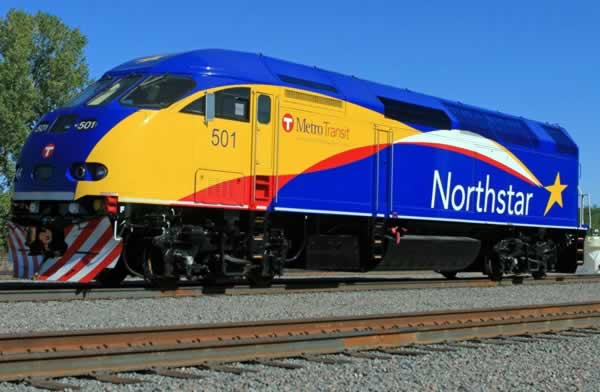
A new locomotive badged with the NorthStar Commuter Rail’s distinctive logo travels over BNSF tracks on its way to the operations maintenance facility at Big Lake. Photo by Steve Glischinski |
|
 |
|

|
 |
TABLE of CONTENTS
 |
New benefits, services offered during open enrollment |
|
By Lisa Yang
Open enrollment for 2009 insurance benefits and services for state employees will be held from Nov. 5-18.
New this year, employees can sign up for a Benny™ debit card, a MasterCard that is pre-loaded with employees’ contribution in their annual pre-tax medical-dental expense account, and if eligible, their employer contribution to the Health Reimbursement Account.
The Benny™ card provides ease and convenience of not having to pay expenses out of pocket or seek reimbursement manually. For more information, download the Benny™ debit card FAQ.
Employees enrolled in the Advantage Health Plan on Jan.1, 2009 will automatically receive a $250 HRA, which is accessed through the Benny™ card or through the regular pre-tax paper reimbursement process. HRA, unlike the Medical/Dental Expense Account, allows dollars to carry over from year-to-year, but permits only employer contributions.
Employees and their covered dependents also can qualify for a $5 co-pay reduction on office visits at their clinic level throughout 2009 by taking an online personal health assessment during open enrollment and agreeing to a follow-up call from a health coach. The assessment will be available starting Nov. 5.
Also new this year, employees will be sent a printed confirmation statement of their 2009 insurance benefits through the mail. Employees have until Dec. 15 to report any inaccuracies found in the statement. Information about how to report inaccuracies will be included in the confirmation statement.
For more information on this year’s open enrollment, visit http://www.doer.state.mn.us/oe/ or download the open enrollment report.
|
 |
|

|
 |
TABLE of CONTENTS
 |
There’s still time to contribute to Combined Charities Campaign |

State employees can continue to pledge to the Combined Charities Campaign through November. As of Nov. 3, 190 Mn/DOT employees have pledged a total of $80,412. |
If you missed the Oct. 31 deadline for contributing to the state’s Combined Charities Campaign, you still can make a difference, reports Ron Bisek, Office of Traffic, Safety and Operations, who is also the statewide campaign coordinator.
As of Nov. 3, 190 Mn/DOT employees had pledged a total of $80,412. Collectively, 2,458 employees from all state agencies have raised $885,424—and the amount is still growing.
“It's important to note that people can still pledge,” Bisek said. “Since we will be tabulating our final numbers on Dec. 1, all pledges made in November will still count toward the grand total.”
He said that the statewide campaign also will be adding in monies raised from fund-raising events at various agencies as well as the paper pledges from the three agencies that are not on SEMA 4.
“We stand a very good chance of getting to our $1 million goal,” he said.
The pledging process can be done by using the Minnesota Employee Self Service Web site. Employees who wish may also make a one-time only donation. All donations are tax deductible. Once the information is complete, a payroll deduction will begin the first paycheck in January 2009 and be applied on every paycheck through December. For one-time only donations, deductions will be taken from the first paycheck in 2009.
For more information about the Combined Charities Campaign go to: https://www.doer.state.mn.us/charities/index.htm or call Amy Zerwas, Mn/DOT’s campaign coordinator, at 651-366-3386.
|
 |
|

|
 |
TABLE of CONTENTS
 |
Mn/DOT wins national information technology award |
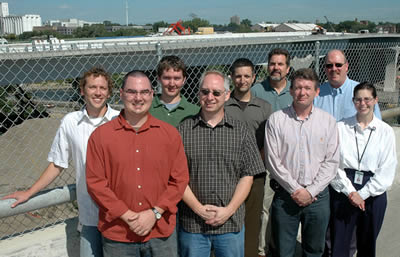
Pictured next to the new Interstate 35W bridge last spring are some members of the collaborating team. (Front left) James Murphy, John Janzen and Paul Weinberger, city of Minneapolis; and Sonia Dickerson, Mn/DOT. (Back row) Steve Misterek, Jon Obermoller and Mark Benishek, Minneapolis; John Harrison and Dan Ross, Mn/DOT. |
Mn/DOT received a best practices award from the National Association of State Chief Information Officers for creating a geographic information system after the Interstate 35W bridge collapse that integrated data from state and local units of government into a single system to quickly provide incident site information to responders and traffic routing information to the public.
NASCIO gave the award to Mn/DOT in the Government to Government category, which recognizes digital government initiatives aimed at enhancing intergovernmental collaboration, cross-jurisdictional services and intergovernmental transaction processing.
Dan Ross, Enterprise GIS Services supervisor, Office of Information and Technology Services, accepted the award on behalf of Mn/DOT.
Mn/DOT worked in partnership with the city of Minneapolis and the Environmental Systems Research Institute, a GIS vendor.
“When tragic events occur in a state or city, they don't require a response from one agency or one jurisdiction, and they don't affect our citizens in just one location,” said Gopal Khanna, chief information officer for the state.
“Everybody everywhere has a need to know, and the response must be coordinated among a diverse and complicated network of service agencies.
He added that the collaboration was “both a tremendous feat and a dramatic demonstration of the power of information technology to facilitate emergency management.”
Besides Ross, Mn/DOT team members were Charlie McCarty and Peter Morey, Enterprise GIS Services; Joella Givens, Adam Julson and Liesa Miller, Metro District GIS support Unit.
For more information about the awards, see the NASCIO Web site, http://www.nascio.org/awards/.
|
 |
|

|
 |
TABLE of CONTENTS
 |
Open house helps raise disability awareness |
 Photo by David Gonzalez Photo by David Gonzalez
|
John Aleksuk, Electronic Data Management Systems, checks out adaptive equipment that can help people who are deaf or hearing-impaired communicate more effectively.
Marie Koehler, a specialist in hearing issues with the Department of Human Services, demonstrates its use.
The open house was held during October, National Disability Awareness Month.
|
 |
|
| |
|



